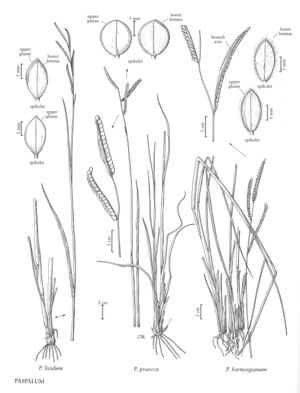Paspalum praecox
Plants perennial; shortly rhizomatous. Culms 5-160 cm, erect, not rooting at the lower nodes; nodes glabrous. Sheaths densely pubescent, occasionally glabrous; ligules 1-2.2 mm; blades to 55 cm long, 2.2-8.3 mm wide, conduplicate (occasionally flat), glabrous below, pubescent above. Panicles terminal, with 2-10 racemosely arranged branches; branches 0.8-10.3 cm, divergent to spreading, often arcuate, terminating in a spikelet; branch axes 0.8-2 mm wide, narrowly winged, glabrous, margins scabrous. Spikelets 2.1-3.1 mm long, 2-2.8 mm wide, paired, imbricate, appressed to divergent from the branch axes, orbicular to suborbicular, stramineous. Lower glumes absent; upper glumes and lower lemmas glabrous, 3-veined, margins entire; upper florets white to light yellow. Caryopses 1.9-2.1 mm, brown. 2n = 20, 40.
Distribution
Va., Miss., Tex., La., Ala., N.C., S.C., Ark., Ill., Ga., Fla.
Discussion
Paspalum praecox grows in pitcher plant bogs, wet pine flatwoods, wet savannahs, prairies, and wet streamhead ecotones. It is restricted to the United States, growing predominantly on the southeastern coastal plain.
Selected References
None.
Lower Taxa
"decumbent" is not a number.
